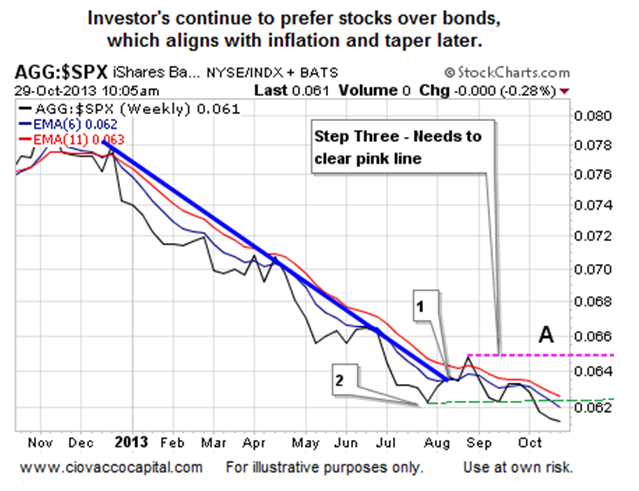
- All Instrument Types
- Indices
- Equities
- ETFs
- Funds
- Commodities
- Currencies
- Crypto
- Bonds
- Certificates
Please try another search

Markets Should Expect ‘More Cowbell’ From Yellen Fed

Problem Solving Bias – We All Have It
Studies show that we all approach problems with an educational bias. For example, engineers develop solutions with math, and CFOs approach problems from a financial perspective. Therefore, it is not surprising that central bankers look at all the problems in the world through a money-printing lens. There is little evidence to support central bankers abandoning this bias in the coming months. From Yahoo Finance:
“We know what the Fed is going to do [under Yellen],” says John Mauldin, chairman of Mauldin Economics and author of the new book Code Red, How to Protect Your Savings From the Coming Crisis. “They’re going to continue to give us, in our generation’s parlance, ‘more cowbell.’”
Inflation vs. Deflation
When prices start to drop, consumers tend to sit on their wallets waiting for a better deal. The previous sentence describes the basic concepts behind a central banker’s worst nightmare – a deflationary spiral. All things being equal when investors are more concerned about deflation relative to inflation, it is a bearish sign for the economy, earnings and stocks. Conversely, when inflation expectations are backed by more conviction than those backing deflation, it is a bullish sign for the economy, earnings and stocks. In a deflationary environment, fixed income becomes attractive since it is easy to “stay ahead of inflation” from a purchasing power perspective. Therefore, if bonds benefit in a deflationary environment and stocks benefit during periods of inflation, we can monitor deflation vs. inflation expectations by tracking the demand for bonds (AGG) relative to stocks (SPY). The ratio continues to show a clear bias toward inflation and stocks.

We originally presented the chart above on October 10 along with the following remarks:
Regular readers know the three steps required for a bullish trend change…Bonds have completed two of the three steps required to establish a bullish trend vs. stocks. Step three requires the ratio below to close above the pink line this week, which would establish a higher high.
The AGG/SPY ratio was unable to clear the pink line (near point A in chart above), which signaled that investors still preferred to be in economically bullish SPY rather than economically bearish AGG. Was the chart helpful? Since October 10, the S&P 500 has gained 77 points.
October Taper ‘Off Table’
The Federal Reserve often sends up policy trial balloons via The Wall Street Journal to see how the financial markets react. Jon Hilsenrath, a WSJ reporter, often pens the trial balloon pieces, which makes him very knowledgeable about monetary policy. Therefore, Mr. Hilsenrath’s comments tend to be widely monitored by the markets. From a October 22 WSJ post:
Mr. Hilsenrath’s conclusions include: October taper to the Fed’s bond-buying program is off the table due to the weak jobs numbers and the recent government shutdown. If the jobs data Tuesday were strong, there would be talk about tapering when the FOMC meets again in December. Now, it’s hard to see if happening before next year. “Ben Bernanke’s term is up in January. I don’t know if he’s going to be able to take his foot off the gas before he leaves.”
CNBC also captured this little nugget from Hilsenrath:
“A lot of Fed officials thought they were going to start winding this thing down by now,” he said. “But it looks like it’s going to go well into 2014. And they’ve got to decide if they’re prepared to let this thing go well over $4 trillion.”
First Sign Of Economic Softening, They Will Print More
Investing involves many things, including psychology and pattern recognition. The Fed has carried a heavy burden trying to turn the global economy with almost no help from Washington on the fiscal policy front. The Fed knows if the economy slips into recession, QE will be labled a failure, which in turn will mean greatly diminished power for the Fed. Human beings tend to protect their power, which is a strong motivator to prove to the markets that QE works. Flipping back to John Mauldin, he looks at the role of QE from an economic angle. From Yahoo Finance:
Mauldin says the first sign of economic softening is sure to see Yellen’s Fed providing more liquidity, just as with the current Fed. It’s a mindset that has become entrenched, and Mauldin blames it on the central bank’s leadership, describing them as “12 men [and women] who now feel that they can manage the business cycle…who think they can override the markets and give us a smoother ride.”
Does QE Have A Stopping Rule?
Quantitative easing is not immune to the natural laws of government intervention and subsidies. One of those laws says once you start subsidizing a market, it is very difficult to stop. This is why many temporary government programs morph over time into permanent fixtures in the economy. From Bloomberg:
“There is a threshold out there somewhere” where markets will become too frothy or the balance sheet becomes too large and the central bank will have to react, said Michael Gapen, a former member of the Fed board’s Division of Monetary Affairs and now a senior U.S. economist at Barclays Plc in New York. “The problem since the beginning of quantitative easing three is there isn’t significant enough clarity for what is the stopping rule.” “One scenario to be worried about may simply be a sharp increase in market-wide rates and spreads at an inopportune time, such that it becomes harder for us to achieve our dual-mandate objectives,” Stein said Sept. 26 in Frankfurt. That “may be among the most relevant” risks to financial stability “when thinking about the costs and benefits of our current highly accommodative policies.”
In the passage above, the most important concept is the battle between negative side effects of QE (bubbles) and the possible systemic risk created by an unexpected big spike in interest rates.
Fear Of Rate Spike vs. Fear Of Bubbles
The Fed understands the bubble argument for stopping QE. They have acknowledged concerning developments in numerous segments of the economy. From Bloomberg:
Kansas City Fed President Esther George, who has dissented against every Federal Open Market Committee decision this year, has highlighted an increase in farmland prices as a concern, and Richard Fisher, president of the Dallas Fed, has pointed to rising home prices in Dallas and Houston as a sign of a U.S. housing bubble. Fed Governors Jeremy Stein and Jerome Powell also have warned this year that some bond yields might be too low for the risk investors are taking.
Investment Implications - Something Has To Change For Bears
When push comes to shove, the fear of another tapering-induced spike in interest rates will most likely win out over asset market bubble concerns. If we have learned one thing from the history of monetary and fiscal policy it is that kicking the can down the road is much more likely than taking a tough love approach to problems.
When In Doubt, Leave It Alone
In the current market, it is much easier to manage positions that were established over the last 2.5 weeks than trying to manage cash looking for ideas. The previous sentence speaks to the importance of good risk-reward entry points. Thankfully, we began redeploying cash on October 10. Profits allow you to give your positions some rope when the inevitable pullback arrives. Good entry points do not come along every day. Therefore, we are in no hurry to exit our current positions, which include broad U.S. exposure (VTI), technology (QQQ), energy (XLE), financials (XLF), and Europe (EFA). Our job now is to discern between volatility to ignore and volatility to respect; a concept that is described in this video segment. With a Fed announcement Wednesday and tepid trends on the earnings and economic fronts, it is extremely important that we keep an open mind about the sustainability of the current advance in equities.
Related Articles

• Trump’s trade war, inflation data, and last batch of earnings will be in focus this week. • DoorDash’s imminent inclusion in the S&P 500 is likely to trigger a wave of...

The big US stocks dominating markets and investors’ portfolios just finished another earnings season. They reported spectacular collective results including record sales, profits,...

“Quality” stocks with strong fundamentals tend to be rewarding places to stash hard-earned money. Since 2009, investing in a basket of quality stocks over a standard index has...
Are you sure you want to block %USER_NAME%?
By doing so, you and %USER_NAME% will not be able to see any of each other's Investing.com's posts.
%USER_NAME% was successfully added to your Block List
Since you’ve just unblocked this person, you must wait 48 hours before renewing the block.
I feel that this comment is:
Thank You!
Your report has been sent to our moderators for review



Add a Comment
We encourage you to use comments to engage with other users, share your perspective and ask questions of authors and each other. However, in order to maintain the high level of discourse we’ve all come to value and expect, please keep the following criteria in mind:
Enrich the conversation, don’t trash it.
Stay focused and on track. Only post material that’s relevant to the topic being discussed.
Be respectful. Even negative opinions can be framed positively and diplomatically. Avoid profanity, slander or personal attacks directed at an author or another user. Racism, sexism and other forms of discrimination will not be tolerated.
Perpetrators of spam or abuse will be deleted from the site and prohibited from future registration at Investing.com’s discretion.